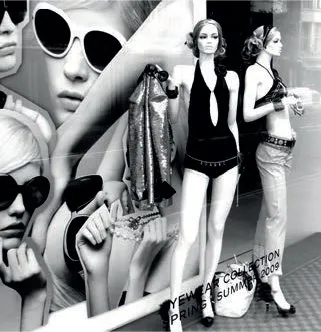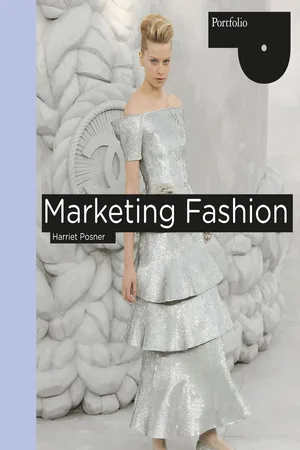![]()
1•
Structure of the Fashion Market
Fashion is a global market with a complex structure that operates on many different levels to reach everyone from fashionistas to those who just purchase clothing as a necessity of everyday life. The range and scope of fashion is immense; from an ornate haute couture gown made by hand in a Paris atelier to a simple mass-produced T-shirt manufactured in China, this opening chapter will provide you with an outline of the basic structure of the fashion industry and explain these different levels of the market. The chapter also features information on the industry’s most influential fashion centres.
Fashion market sectors
The fashion market is broken down into specific sectors so that companies are better able to analyse market data and monitor their business results more effectively. Market statistics can be compiled and analysed by one or more of the following criteria:
•Market or product category
Apparel, accessories, perfume or homeware. The apparel market can be further subdivided into womenswear, menswear and childrenswear
•Product type, end-use of product or fashion style
Denim, lingerie, sportswear, formal wear or contemporary fashion
The diagram gives an indication of some of the key market and product sectors within womenswear, menswear, childrenswear and accessories. As new niche markets develop, so the chart can be adapted to include emerging sectors, for example, clubwear, urban wear, and surfwear.
•Market level
Couture, luxury, mid-market or value market
•Location of market
Global, international, national or regional
Market information
Fashion analysts publish market reports and data analysis on most of the key international fashion market sectors. This information is helpful in assessing the relative size of specific markets or estimating future market potential.
Womens-, mens- and childrenswear Data from Verdict Retail, part of the Datamonitor Group, indicates that in 2009 consumers spent £19.1 billion on womenswear with spending on menswear and childrenswear at £9.0 billion and £4.6 billion respectively. The market in the US is considerably larger; for 2009 the womenswear market was US$104 billion, menswear US$51 billion and childrenswear US$33.5 billion. The childrenswear market is typically defined as clothing for children under the age of 14. The main sectors are infants’ clothing (babies and toddlers under two years old), girls’ clothing (ages 2–14) and boys’ clothing (ages 2–14).
Accessories Accessories and footwear are important sectors, contributing a high percentage of the sales turnover for many brands. Global sales of fashion and leather accessory goods across the LVMH brands, including Louis Vuitton, Fendi, Christian Dior and Marc Jacobs, accounted for 34 per cent of the group’s overall turnover in 2008, with sales of just under €3 billion in the first half of 2009 (www.lvmh.com 2009). In the UK, the women’s accessory market was worth £700 million in 2007, with bags accounting for £468 million. Data from Mintel showed that between 2002 and 2007, sales of handbags in the UK increased 139 per cent with year on year growth of 30 per cent. However, the impact of the recession slowed this growth to 18 per cent in 2008. The fashion accessory market in the US was worth around US$16 billion in 2008 and predicted to reach US$20 billion by 2012 (Packaged Facts 2009). Footwear sales in the UK during 2007 were worth just over £6 billion and data from the American Apparel and Footwear Association puts footwear sales in the US at just over US$59 billion.
Bags and accessories displayed at Louis Vuitton.
The Chanel eyewear collection for Spring/Summer 2009 is promoted in a window display.
Perfume The fragrance and perfume market is a vital business sector for luxury fashion brands. Fragrance and cosmetics sales at LVMH, for example, accounted for 16 per cent of the group’s revenue in 2007 and 2008. Introducing a fragrance as a strategy for growth is not a new phenomenon. Paul Poiret can lay claim to be the first fashion designer to launch a line of perfumes and cosmetics in 1911; the House of Worth introduced a branded perfume in 1925; and Gabrielle ‘Coco’ Chanel launched the world famous Chanel Nº 5 in 1921. The global fragrance and perfume market is predicted to reach sales of US$ 33 billion by 2012 (Global Industry Analysts, Inc 2008) with the European share of the world market estimated at 46 per cent in 2008.
Lifestyle and homeware This market can provide opportunity for a fashion brand or retailer wishing to develop and diversify its business. Ralph Lauren is a brand famous for its lifestyle and homeware products, and US fashion retailer Anthropologie offers an extensive range of bedding, curtains, cushions, tabletop and linens as well as lifestyle products such as bathroom products, candles and stationery. The Spanish retailer Zara has stand-alone home stores offering a similar range of products.
Other markets – denim and sportswear The global denim market is reputed to be worth about US$50 billion annually and data provided by the NPD Group, Inc indicates that denim accounts for 17 per cent of all apparel purchases, with jeans making up 73 per cent of this figure. Over 800 million denim jeans are bought in the world each year. Fashion industry analysts at Mintel predict that by 2012 the UK jeans market will exceed £2 billion, with the men’s sector forecast to top £1 billion, women’s jeans £846 million and children’s jeans in the region of £136 million.
An advert for Shocking, the fragrance launched by Elsa Schiaparelli in 1937. The curvaceous bottle, shaped like a woman’s torso, was modelled on the physique of Mae West and designed by the surrealist artist Léonor Fini.
The Jean Paul Gaultier signature fragrance takes its inspiration for the bottle design from the Schiaparelli original.
A poster advertises the launch of John Galliano’s first signature fragrance in 2008.
Fashion market levels
Fashion can be divided into two overarching levels:
•Haute couture and couture
•Ready-to-wear
Haute couture
Haute couture is literally defined as ‘high sewing’ or ‘fine sewing’ and is fashion at its highest level. Haute couture operates at a quality and standard way above that of luxury designer ready-to-wear. Prices are extremely high (an haute couture dress can sell for a six-figure sum) so there is an unwritten rule of limiting sales of any garment of over £100,000 to one per continent to ensure the exclusivity that clients expect. For lesser-priced garments, sales are usually confined to no more than three per continent. Haute couture clients view themselves as art patrons and consider these clothes to be a collectable form of art and an investment. The term ‘haute couture’ is protected by law and governed by very strict rules set by the Chambre Syndicale de la Haute Couture in Paris. To be classified as a bona fide haute couturier a fashion house must create made-to-order garments for private clients. They must also produce two collections a year, employ a minimum of 15 full-time staff, run an atelier in Paris and show a set minimum of runway looks, or ‘exits’, as they are known, of evening and daywear. In the 1980s and 1990s the Italian designer Valentino showed over 180 exits for his haute couture show, now he produces only 40. Very few design houses are approved as haute couture establishments and allowed to show in Paris; Chanel, Dior, Jean Paul Gaultier, Valentino, Giorgio Armani, Jean-Louis Scherrer, Elie Saab, Dominique Sirop, Stéphane Rolland and Franck Sorbier are all recognized as true haute couturiers by the Chambre Syndicale.
Haute couture sits at the pinnacle of fashion. Although only a small sector of the overall market, its influence on designer and high-street fashion is of great importance. Designers distil ideas from their own couture collections and use them in a more commercial format for their ready-to-wear collections. In turn the designer and luxury brand ready-to-wear collections set the trends followed by mass market fashion retailers. When trends work their way down from the top of the market to the bottom, it is known as a trickle-down effect.
Haute couture relies on the expertise of many highly skilled artisans and craftspeople who labour behind the scenes to produce all the luxurious embroideries, trimmings and accessories required by the haute couturiers. Traditionally Paris has been home to a large number of studios or ateliers specializing in millinery, shoemaking, embroidery, beading, creating decorative flowers, buttons and costume jewellery. In 1900, Paris had over 300 plumassiers or feather specialists; today the Lemarié atelier is virtually the only one still in existence. Chanel bought the business along with five other specialist craft ateliers: Michel, specializing in millinery; shoemakers, Massaro; embroidery house, Lesage; button and costume jewellery makers, Desrues; and the gold and silversmith, Goosens. While many argue that something as arcane and extravagant as haute couture cannot or should not survive, it seems that demand has not diminished. Chanel employs around 200 couture specialists, while haute couture sales at Christian Dior couture were worth €765 million in 2008, an increase of 35 per cent on the previous year. However, haute couture is a relatively small business in fashion terms; couture at Dior accounts for only 4 per cent of overall LVMH sales. The real value of haute couture is its power as a marketing tool. Global names such as Chanel, Armani and Dior receive valuable press coverage of their haute couture collections, raising the status and desirability of their brand and keeping it in the public eye.
Fashion designers that are not recognized by the Chambre Syndicale can still produce exclusive custom-made clothing but this must be marketed as couture rather than haute couture. Prices for couture can still be high. The British designer Giles Deacon produces two or three couture pieces a year and a dress may cost more than £40,000. The price of a Vera Wang wedding dress can be in the region of US$25,000, although in an attempt to keep customers happy during the recession, Wang introduced what she calls demi-couture with a lower price tag.
Christian Dior haute couture for Autumn/Winter 2009/10. Gowns created for this exclusive market are sumptuously embellished with hand-worked beading and embroidery.
Ready-to-wear
Fashion product that is not custom-made for an individual client is known as ready-to-wear or off-the-peg clothing. Ready-to-wear garments are premade, come in predetermined sizes and are usually mass-produced and industrially manufactured. Ready-to-wear fashion is available at all levels of the market including:
•High-end fashion
•Middle market
•High street
•Value fashion
Middle market fashion product is designed and priced to cater for customers wishing to purchase at a level between luxury and mass market. A designer or fashion brand that has established itself within the high-end market, may decide to introduce a secondary diffusion line or bridge line, as it is known in the United States, so that they can extend their brand into the middle market. See by Chloe could be classed as a diffusion line, as could Betty Jackson Two, the secondary line to the main Betty Jackson range. High-street retailers such as Banana Republic, Cos, Hoss Intropia, Whistles and Reiss can also be considered as mid-market. The term middle market is not particularly inspiring and is not always perceived by retail brands as a position they wish to aspire to. Some combat this by re-stating their market level, claiming they offer affordable luxury or masstige (prestige for the masses, or mass luxury) rather than mid-market fashion. Affordable luxury and masstige fashion are seen as an important market opportunity now that so many fashion consumers view luxury as something that should be available to all, even those with limited budgets.
Mass market fashion is a term used when referring to high-street multiples or fashion retail chains such as Gap, Topsho...








